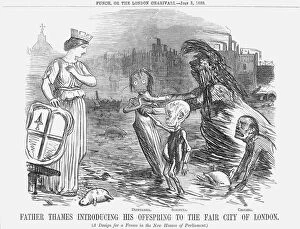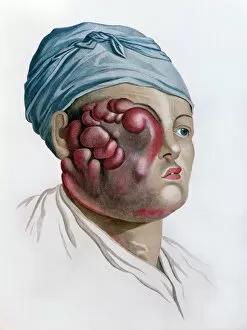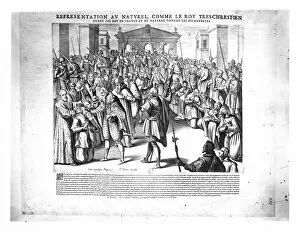Kings Evil Collection
"Unveiling the Dark Legacy: Father Thames Introduces His Offspring to the Fair City of London, 1858" In a mesmerizing engraving titled "Queen Anne's Touch
All Professionally Made to Order for Quick Shipping
"Unveiling the Dark Legacy: Father Thames Introduces His Offspring to the Fair City of London, 1858" In a mesmerizing engraving titled "Queen Anne's Touch, " the power of royalty is revealed as a potential remedy for an ancient affliction known as scrofula. This cancerous disease, described meticulously in "Description des Maladies de la Peau, " plagued countless individuals during the 19th century. A glimpse into history unfolds through Ms Sup Turc 693 fol. 29v, where a delicate vellum showcases the cauterization of scrofula back in 1466. The vivid lithograph "Comic Early English History: Touching for the Kings Evil" captures both curiosity and skepticism surrounding this unconventional treatment. Scrofula's grip on society was undeniable; it became endemic and demanded attention from medical experts like Baron Jean Louis Alibert. His book's illustration sheds light on this persistent ailment that haunted generations. Ehrharts Water-Betony, also known as Scrophularia Ehrharti, emerges from a 19th-century botanical depiction—a testament to mankind's quest for remedies against such diseases. The captivating painting by Frederick-Hendrik van den Hove transports us to Charles II's reign when he personally touched patients afflicted with scrofula around 1680—an act believed to cure them of their suffering. "The Manner of his Majesty Curing the Disease Called King s-Evil" offers an engraved insight into how monarchs sought divine intervention against this dreaded malady. St. Louis himself is depicted curing sufferers of scrofula in an oil-on-canvas masterpiece that exudes compassion and hope. Not limited by time or borders, Henri IV transcends centuries through an evocative black-and-white photograph capturing him curing those tormented by scrofula—an enduring symbol of royal benevolence.












